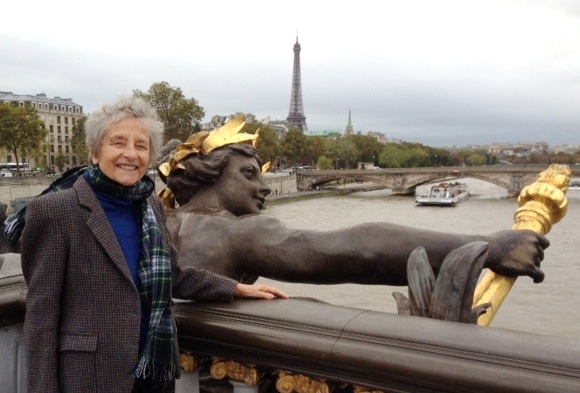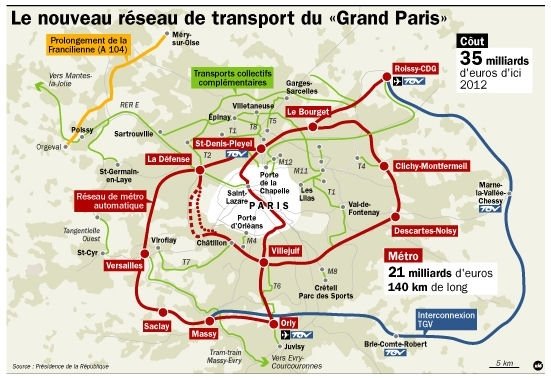
On January 1st, 2016 the “Metropole du Grand Paris” became official . This new territorial organization, named Etablissement Public de Cooperation Intercommunale (EPCI), includes Paris plus parts of three departements – Hauts de Seine, Seine St Denis and Val de Marne– with seven millions inhabitants.
What is the Grand Paris ? Why is it a necessity? Is it a decisive step forward? Does it have models in other countries? What are the problems it is facing ? Anyone curious to learn how France works and what lies in the future might be interested in having a look at this new concept.
The project was born in 2007 under President Sarkozy’s mandate. When the Socialists came to power in 2012, they immediately modified the initial proposal. But the authors of the project kept plodding away. Its official status represents a progress toward the long term objective, which is to be ready for the Olympic Games in 2024 and the 2025 World Fair, in the event Paris is chosen.
The French capital is choking inside the beltway and something had to be done: the town of Paris is too small and too expensive even to accommodate the middle class; suburbia, which used to provide a labor force in the former industrial economy, is hit today by unemployment ; this same suburbia feels isolated because of inadequate public transport (if you drive into work you might spend hours in bouchons or traffic jams on the highway). The RERs (Regional Rapid Transit) are overcrowded and often unsafe.

In the new project (see map above), the backbone of public transport will be the Grand Paris Express, six new lines of totally automated trains circling the Paris agglomeration and connecting, for the first time, the suburbs. For instance it will be possible to go directly from Boulogne at the west of Paris to Marne la Vallée (the location of Euro-Disney) in the east.
Until now any change has been hampered by administrative complexity – layer upon layer of authorities, like a millefeuille – (a well known and sinful pastry).
The Grand Paris will include 132 communes. Mayors wield enormous power in France. That power is particularly obvious at election time when building permits seem to multiply. The mayors will have to learn how to live together and adapt to the new administrative structure, which now includes other layers of the bureaucratic millefeuille, namely the departements and the regions (this year they have been reduced from 22 to 13), piled on top.
France is essentially a centralized state. Culture, finance, education of the elite, research and development, luxury shops, are heavily concentrated in Paris and the Ile de France. Napoleon, Baron Haussmann, General De Gaulle are the great historical figures who left their imprint in the centralization process. What we are witnessing today is an explosion of the center. It is even likely that the boundaries of the Grand Paris may expand.
The Grand Paris will be made of ‘clusters’ (in English in the French text) to bring Paris to par with New York , London or Tokyo. According to the official description of the project, “Greater Paris relies on seven thematic competitive clusters.” The list includes : Air Space, Trade, Sustainable City, Digital Creation, International Trade, and Life Sciences. A financial center already exists in the Defense district, which looks like a mini-Manhattan. ,
Saclay, 20 kilometers south of Paris, is the most impressive and modernistic of these clusters. Until recently an agricultural land, it is now the hub of Research and Development. Many élite Grandes Ecoles, like Polytechnique, have moved there, as well as 23 universities and the headquarters of major companies. Its emblematic building, spreading over the fields like a giant flying saucer, is the Synchroton Soleil with its accelerators to study light. Pierre Veltz, an engineer and former head of Saclay, is confident that it will become an European Silicon Valley.
 About the author: Nicole Prévost Logan divides her time between Essex and Paris, spending summers in the former and winters in the latter. She writes a regular column for us from her Paris home where her topics will include politics, economy, social unrest — mostly in France — but also in other European countries. She also covers a variety of art exhibits and the performing arts in Europe. Logan is the author of ‘Forever on the Road: A Franco-American Family’s Thirty Years in the Foreign Service,’ an autobiography of her life as the wife of an overseas diplomat, who lived in 10 foreign countries on three continents. Her experiences during her foreign service life included being in Lebanon when civil war erupted, excavating a medieval city in Moscow and spending a week under house arrest in Guinea.
About the author: Nicole Prévost Logan divides her time between Essex and Paris, spending summers in the former and winters in the latter. She writes a regular column for us from her Paris home where her topics will include politics, economy, social unrest — mostly in France — but also in other European countries. She also covers a variety of art exhibits and the performing arts in Europe. Logan is the author of ‘Forever on the Road: A Franco-American Family’s Thirty Years in the Foreign Service,’ an autobiography of her life as the wife of an overseas diplomat, who lived in 10 foreign countries on three continents. Her experiences during her foreign service life included being in Lebanon when civil war erupted, excavating a medieval city in Moscow and spending a week under house arrest in Guinea.